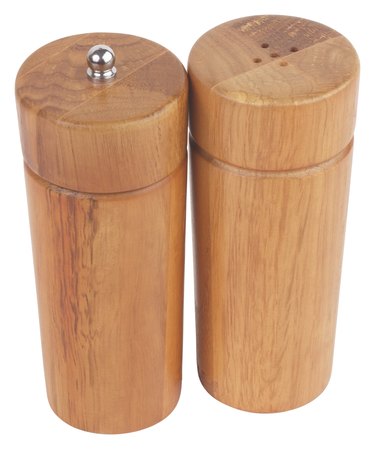Things You'll Need
Woodturning blank (square),approximately 1-foot in length and at least 3-inches in diameter.
Pencil
Roughing gouge
Skew chisel

There are two basic types of turnings when it comes to a wood lathe: spindle turning; and bowl turning. But no matter which one is your preference, learning to turn a cylinder, or spindle turning, is a beginner's technique that must be practiced. Mastering this basic procedure helps you develop skills that will carry over into the beginning of any woodturning project you undertake. Here is a straightforward way to take a square piece of stock and make it into a cylinder.
Step 1
Mark an "x" across each end of your wood blank. Do this by marking a straight line from one corner to the next, rotating the piece 90-degrees and drawing another line from one corner to the other. Where the lines intersect is the center of the end piece. Repeat this step on the opposite end of your blank.
Video of the Day
Step 2
Mount the blank between centers on your lathe, using the intersecting lines on the end as a guide to place the point of your drive spur in the headstock and the point of your live center in the tailstock. Turn the tailstock handle until the piece fits snugly and securely against the drive spur. Lock your tailstock in place. Rotate the piece manually to ensure it is secure.
Step 3
Adjust your tool rest until the center is level with the center of your wood blank. Again, manually rotate your piece to ensure that it clears the tool-rest.
Step 4
Turn your lathe on its slowest speed and watch for any imbalance in your piece. When satisfied, increase the speed of your lathe to approximately 500-700 rpms.
Step 5
Place your roughing gouge on your tool rest pointing up at a 45-degree angle. Push the gouge into the spinning blank by slowly lifting the handle until the cutting edge produces smooth cuts. This is the proper tool position for roughing the blank.
Step 6
Move the roughing gouge back and forth across the tool rest in a sweeping motion and adjust the handle upward forcing the blade into the wood as the square blank becomes more and more round. Stop the lathe periodically to check your work.
Step 7
Continue roughing the blank until all of the flat surfaces have been cut away. Stop the lathe and switch to your skew chisel. Re-adjust your tool-rest, if required, until it is in the center of your blank.
Step 8
Turn on your lathe and increase the speed to achieve your finishing cuts. Place the blade of the skew chisel against the spinning wood and slowly bring up the tip of the handle until the blade starts to shear the wood fibers.
Step 9
Move the blade of the skew chisel back and forth across the surface of the wood refining the shape into a smooth cylinder that will become the starting point of your turning project;s design.
Tip
Spindle turning is a skill that every woodturner should master. Out of the basic shape of the cylinder comes the bead and cove cuts that you will repeat in almost every woodturning project you undertake. Laying the cutting edge of the tool against the wood and lifting the handle until the blade cuts is called "riding the bevel". Most woodturning tools have a bevel beneath the cutting edge that rides along the wood as it is cut, giving support to the cutting edge of the blade. Learning how to "ride the bevel" will make your woodturning tools cut instead of scrape the wood. Giving your project a much finer finish. As your skill at woodturning grows, increase the speed of your lathe to shorten the process and provide finer shavings from your tools.
Warning
Woodturning can be a dangerous activity. Read and follow all manufacturer's safety protocols and guidelines. Wear adequate eye protection and have plenty of illumination around your work piece. Thoroughly read the manual of your lathe before turning your first project. If you still need assistance, check your area for local woodturning clubs, which often have free monthly workshops for first time turners.
Video of the Day